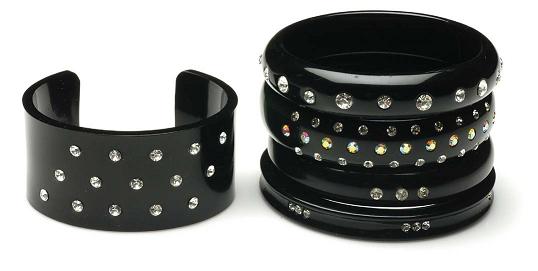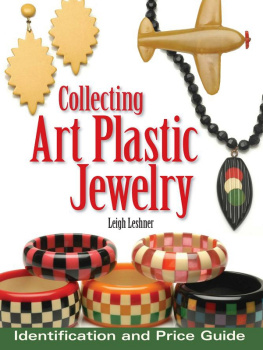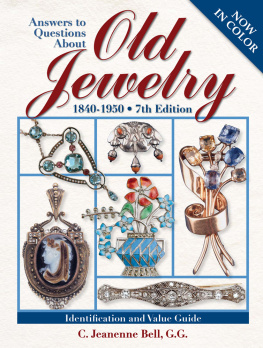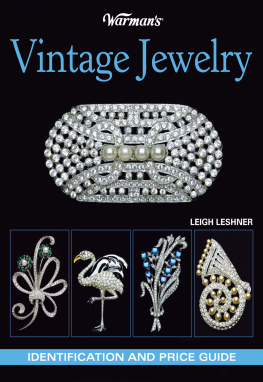
 Collecting
Collecting
Art Plastic
Jewelry Leigh Leshner  Identification and Price Guide 2005 Leigh Leshner
Identification and Price Guide 2005 Leigh Leshner
Published by 
700 East State Street Iola, WI 54990-0001
715-445-2214 888-457-2873
Our toll-free number to place an order or obtain
a free catalog is (800) 258-0929. All rights reserved. No portion of this publication may be reproduced or transmitted in any form or by any means, electronic or mechanical, including photocopy, recording, or any information storage and retrieval system, without permission in writing from the publisher, except by a reviewer who may quote brief passages in a critical article or review to be printed in a magazine or newspaper, or electronically transmitted on radio, television, or the Internet. Library of Congress Catalog Number: 2004113677 ISBN: 0-87349-954-9
eISBN: 978-1-44022-524-6 Designed by Kay Sanders
Edited by Tracy L. Schmidt Printed in the United States of America A cknowledgments  I wish to thank my parents, Robert and Carol Leshner, for always being there for me and encouraging me and inspiring me to do my best. Thanks also to: Vintage Fashion and Costume Jewelry editor Lucille Tempesta, author Marcia Brown, and dealer/collector Barbara Wood for their editorial expertise.
I wish to thank my parents, Robert and Carol Leshner, for always being there for me and encouraging me and inspiring me to do my best. Thanks also to: Vintage Fashion and Costume Jewelry editor Lucille Tempesta, author Marcia Brown, and dealer/collector Barbara Wood for their editorial expertise.
Maurice Childs for his extraordinary photography. Marcia Brown, Judy Clarke, Ann Eliason, Jim Foltz, Barbara Harris, Karen Kennedy, Lori Kizer, Karen Kronimus, Carol Leshner, Janet Lawwill, Kristin Martinez, Elizabeth Rowlands, BeeGee McBride, Sheri Peti, Jackie Weeks, and Barbara Wood for providing jewelry from their private collections. My editor Tracy Schmidt, page designer Kay Sanders, and acquisitions editor Paul Kennedy.  Special thanksgo to MauriceChilds for hisextraordinaryphotography. C ontents
Special thanksgo to MauriceChilds for hisextraordinaryphotography. C ontents 
 Left: contemporary hard plastic cuff with rhinestones,$30;
Left: contemporary hard plastic cuff with rhinestones,$30;
right: contemporary hard plastic bangles with rhinestones,$24each. I ntroduction  Art plastic jewelry has been a favorite of collectors for decades. This book will feature jewelry made from the various types of plastics: celluloid, Bakelite, Lucite, thermoplastics, and thermoset plastics. Plastic jewelry is often referred to as novelty jewelry, because it was fun and whimsical.
Art plastic jewelry has been a favorite of collectors for decades. This book will feature jewelry made from the various types of plastics: celluloid, Bakelite, Lucite, thermoplastics, and thermoset plastics. Plastic jewelry is often referred to as novelty jewelry, because it was fun and whimsical.
Designers have used the relatively inexpensive material to create all types of jewelry from necklaces and rings to pins and bangles. Each piece is unique, reflecting the designers desire to bring life to the jewelry through the use of color and carvings. The number of collectors has grown tremendously. Most people know what Bakelite is and the pieces on the market are both collectible and valuable. In fact, many special pieces bring prices in the thousands of dollars. With this increased interest, people want to know how to tell the difference between the different types of plastics, the history behind the jewelry, and what it is worth.
This book will provide you with the answers to these questions.  Lady brooch, resin,$275.
Lady brooch, resin,$275. Evans wave bangles, resin,$200each. H istory
Evans wave bangles, resin,$200each. H istory  Plastics is a Greek word meaning to mold or to form, and that is the perfect description for the material we commonly refer to as plastic. Plastic is a material that generally can be shaped and molded under heat and pressure. Plastics come in all colors from clear to vibrant hues of fuchsia, red, and orange to more subdued colors of black, brown, and avocado. There are two types of plastics: thermoplastic and thermoset. A thermoset can be reheated and reshaped such as acrylic, gutta-percha, and polyethylene.
Plastics is a Greek word meaning to mold or to form, and that is the perfect description for the material we commonly refer to as plastic. Plastic is a material that generally can be shaped and molded under heat and pressure. Plastics come in all colors from clear to vibrant hues of fuchsia, red, and orange to more subdued colors of black, brown, and avocado. There are two types of plastics: thermoplastic and thermoset. A thermoset can be reheated and reshaped such as acrylic, gutta-percha, and polyethylene.
A thermoplastic is a plastic that is heated, causing a chemical reaction. The plastic is then shaped into an object that permanently hardens and becomes heat resistant. Melamine and Bakelite are thermoplastics. Plastics have been used for purposes of all kinds ranging from radio casings to furniture to other utilitarian purposes. It has also been used to make jewelry. Everything you could imagine: necklaces, bracelets, pins, dress clips, rings, earrings, buckles, buttons, and bangles.
Often pieces would be made entirely out of plastic, while at other times, plastic was used simply to accent a piece. Because of World War II, the use of pot metal (the tin and lead used in pot metal) was prohibited for use other than for the military. Designers began using other materials to make fun and fanciful jewelry that put a smile on the wearers face. Necklaces varied from plain to carved. There were simple bead necklaces, pendants, charm necklaces, faceted necklaces, necklaces made of fruits and vegetables, and necklaces with rhinestones. There were bangles accented with various materials such as rhinestones, metal and hand painting.
They were carved, reverse carved and injected with flowers, bugs, and other items. There were hinged cuffs, two-tone bangles, polka dots, gumdrops, striped, marbled, bow tie, stretch bracelets, and charm bracelets. Brooches ranged from plain to detailed and ornate to articulated, so that parts of the pin actually moved.  Thermoset plastic bangles,$75each.
Thermoset plastic bangles,$75each. Carved Bakelite bangles, from left: marbeled green, red, and black,$395each.
Carved Bakelite bangles, from left: marbeled green, red, and black,$395each. Reverse-carved Lucite butterfly brooch and earrings,$85. Prison rings received their distinctive name because inmates in prison would take a toothbrush, a shaving brush or a pen and melt it down. They would then use celluloid to bond it together. They would often add pictures onto the rings front.
Reverse-carved Lucite butterfly brooch and earrings,$85. Prison rings received their distinctive name because inmates in prison would take a toothbrush, a shaving brush or a pen and melt it down. They would then use celluloid to bond it together. They would often add pictures onto the rings front.
Next page













 Collecting
Collecting Identification and Price Guide 2005 Leigh Leshner
Identification and Price Guide 2005 Leigh Leshner
 I wish to thank my parents, Robert and Carol Leshner, for always being there for me and encouraging me and inspiring me to do my best. Thanks also to: Vintage Fashion and Costume Jewelry editor Lucille Tempesta, author Marcia Brown, and dealer/collector Barbara Wood for their editorial expertise.
I wish to thank my parents, Robert and Carol Leshner, for always being there for me and encouraging me and inspiring me to do my best. Thanks also to: Vintage Fashion and Costume Jewelry editor Lucille Tempesta, author Marcia Brown, and dealer/collector Barbara Wood for their editorial expertise. Special thanksgo to MauriceChilds for hisextraordinaryphotography. C ontents
Special thanksgo to MauriceChilds for hisextraordinaryphotography. C ontents  Left: contemporary hard plastic cuff with rhinestones,$30;
Left: contemporary hard plastic cuff with rhinestones,$30; Lady brooch, resin,$275.
Lady brooch, resin,$275. Evans wave bangles, resin,$200each. H istory
Evans wave bangles, resin,$200each. H istory  Thermoset plastic bangles,$75each.
Thermoset plastic bangles,$75each. Carved Bakelite bangles, from left: marbeled green, red, and black,$395each.
Carved Bakelite bangles, from left: marbeled green, red, and black,$395each. Reverse-carved Lucite butterfly brooch and earrings,$85. Prison rings received their distinctive name because inmates in prison would take a toothbrush, a shaving brush or a pen and melt it down. They would then use celluloid to bond it together. They would often add pictures onto the rings front.
Reverse-carved Lucite butterfly brooch and earrings,$85. Prison rings received their distinctive name because inmates in prison would take a toothbrush, a shaving brush or a pen and melt it down. They would then use celluloid to bond it together. They would often add pictures onto the rings front.